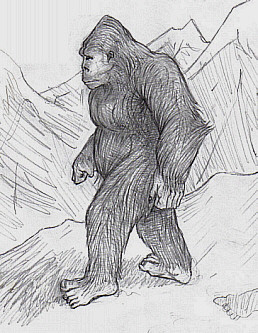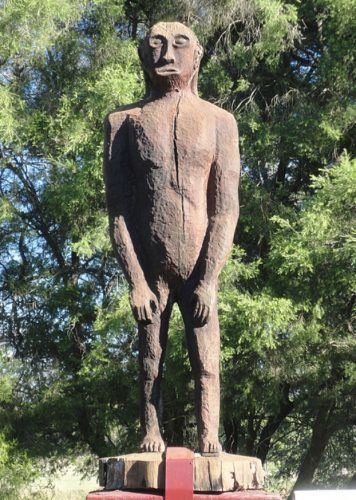Date of Discovery
First reported in Sydney by a man in 1790, before being identified as the Yowie, Modern Geography: A Description of the Empires, Kingdoms, States, and Colonies: With the Oceans, Seas, and Isles: In All Parts of the World was published by John Pinkerton in 1804. The Yowie was really only entered into the written record by name in 1875, as used among the Kámilarói people, by Reverend William Ridley in his book, “Kámilarói and Other Australian Languages.” It is clear, however, that like many other oral cultures and traditions, this cryptid was a part of the culture long before it was used withing Ridley’s texts.
Name
The name Yowie, or Yō-wī as the Kámilarói people, is said to translate into, “a spirit that roams over the earth at night,” but it’s unclear when and where this term began to be used to describe unidentified Australian hominids. This creature is also known as the hairy man and Yahoos.
Physical Description
Within Pinkerton’s book, there is a side-comment about a population of Aborigines that shared Sydney Harbor with another “tribe,” but the people of this tribe were not Aborigines themselves–they were described as creatures with flat-noses and wide nostrils, they also had thick eyebrows and sunken eyes. It also said that their mouths were of “prodigious width,” with a prominent jawline and thick lips. The Aborigines of the area considered them as a separate people entirely–here they were called Yahoos or Yowies, which translated to “hairy people.”
Eye-witnesses to the Yowie have created sketches of what they believe they encountered and all of which depicted a strong, large, and hairy, eight-foot-tall man, who has a fairly flat face, large eyes and nostrils, as well as a reddish-brown coat of fur. These creatures possess an aggressive nature when they feel threatened, or when their territory is being encroached upon.
Photographic evidence of their footprints shows that they often have six toes and are near twice the size of an adult male human’s foot in length and width.
The Yowie is essentially the Australian version of the American Bigfoot, Yeti, Sasquatch, or Tornit.
There is actually a second physical account of the Yowie in Australia, which leads many hunters to believe there are actually two separate species of Yowie. The first, which was described above refers to the Gigantopithecus which is between six and ten feet tall, often weighing up to one thousand pounds. The second, smaller species of Yowie is said to be between four and five feet tall, but many people believe that this could be an ancient species of hominid that has somehow avoided extinction.
Origin
The Yowie has roots in Aboriginal oral history and is the folkloric creature of the Outback; the Kuku Yalanji Tribe of the far north Queensland is said to have coexisted with the Yowie for centuries. This is reminiscent of the Inuit tribe and the Tornit of Baffin Bay, Canada, who also have a long oral history of attacks by the Yowie of legend.
Mythology and Lore
Dean Harrison, a famous Yowie hunter believes that over the years there have been thousands of sightings of the Yowie. In particular, the Blue Mountains in New South Wales seems to be a hot zone for Yowie sightings, along with the Sunshine and Gold coasts of Queensland, and most recently the Mandurah area in Western Australia. They tend to prefer thick bush and are excellent at camouflaging themselves, inhabiting the area of the eastern seaboard along the Great Dividing Range.
These creatures can be incredibly far roaming but are said to have a territory that they operate in family units. So why isn’t there any physical evidence of these creatures? It is believed that due to the tendencies of Yowie to live within family units, that they operate as a community, and take care of their dead; this would leave no physical evidence of them to be blatantly evident.
Modern Pop-Culture References
Books & Literature
Movies
- The Yowie (2010)
Podcast Episodes
Is there anything we missed about the Yowie? Let us know in the comments section below!

Georgia-based author and artist, Mary has been a horror aficionado since the mid-2000s. Originally a hobby artist and writer, she found her niche in the horror industry in late 2019 and hasn’t looked back since. Mary’s evolution into a horror expert allowed her to express herself truly for the first time in her life. Now, she prides herself on indulging in the stuff of nightmares.
Mary also moonlights as a content creator across multiple social media platforms—breaking down horror tropes on YouTube, as well as playing horror games and broadcasting live digital art sessions on Twitch.


